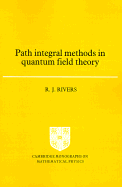Book contents
- Frontmatter
- Contents
- Preface
- 1 Scalar Green functions and their perturbative solutions
- 2 Connected Green functions and their one-particle irreducible components
- 3 Regularisation and renormalisation
- 4 The scalar functional integral
- 5 Series expansions and their summation
- 6 Taking the path integral more seriously
- 7 Quantum theory on non-simply-connected configuration spaces
- 8 Stochastic quantisation
- 9 Fermions
- 10 Quantum electrodynamics
- 11 Non-Abelian gauge theories
- 12 Explicit symmetry breaking and its classical limit
- 13 The effective potential
- 14 Field theory at non-zero temperature
- 15 Field theory at non-zero temperature: real-time formulation
- 16 Instantons
- 17 Composite fields and the large-N limit
- References
- Index
8 - Stochastic quantisation
Published online by Cambridge University Press: 04 April 2011
- Frontmatter
- Contents
- Preface
- 1 Scalar Green functions and their perturbative solutions
- 2 Connected Green functions and their one-particle irreducible components
- 3 Regularisation and renormalisation
- 4 The scalar functional integral
- 5 Series expansions and their summation
- 6 Taking the path integral more seriously
- 7 Quantum theory on non-simply-connected configuration spaces
- 8 Stochastic quantisation
- 9 Fermions
- 10 Quantum electrodynamics
- 11 Non-Abelian gauge theories
- 12 Explicit symmetry breaking and its classical limit
- 13 The effective potential
- 14 Field theory at non-zero temperature
- 15 Field theory at non-zero temperature: real-time formulation
- 16 Instantons
- 17 Composite fields and the large-N limit
- References
- Index
Summary
So far our approximations have been wholly analytic, essentially based on perturbation series. The calculation of (g − 2) for the electron has shown just how successful this approach can be.
However, in many ways (g − 2) is an exception. Most quantities that we would like to calculate (e.g. the pion mass in quantum chromodynamics, the field theory of the strong interactions) cannot be approached analytically. Although analytic methods do give us a lot of information (that is, after all, what this book is about) it is often of a qualitative nature. For this reason a variety of numerical methods have been developed for approximating the path integral directly. Bypassing problems of measure, they typically involve putting the theory on a Euclidean lattice, as in the case of the regularised ZΛ(j) of (6.74). The resulting integrals can then be calculated directly, although a sizeable lattice requires considerable computing resources. All the uncertainties of the method are displaced into the problem of recovering the continuum limit.
It is often difficult to link such tactics to the analytic ideas of continuum field theory. Before turning to more realistic theories we shall give a brief description of an alternative interpretation of formal Euclidean path integrals, proposed by Parisi and Wu (1981).
- Type
- Chapter
- Information
- Path Integral Methods in Quantum Field Theory , pp. 145 - 158Publisher: Cambridge University PressPrint publication year: 1987

